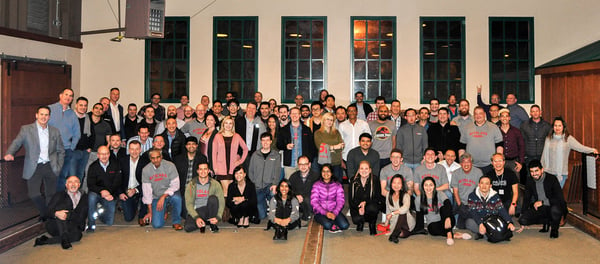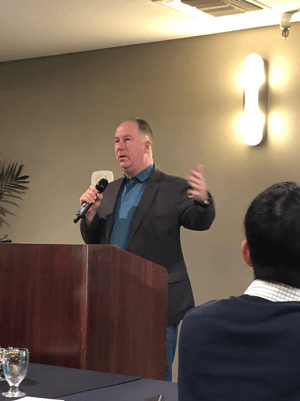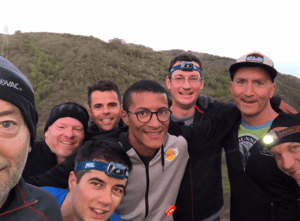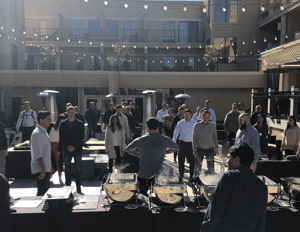Home » Cybersecurity » Cloud Security » The Perfect Sales Kickoff
The Perfect Sales Kickoff

The Perfect Sales Kick Off
SKO ‘19 is in the bag, the team has left, and it feels like the party has ended. It is now time to reflect. Did we achieve our goals? What did we learn?
Is the team motivated? Yes ✔
Did we manage to educate them? Yes ✔
Are we aligned on messaging, strategy, philosophy, and being a cohesive global team? Yes ✔
Did we celebrate our success? Yes, enthusiastically ✔✔
Were there zero HR violations, injuries, or arrests? YES ✔✔✔
In that case, we can officially call Bitglass SKO ‘19 a rip-roaring success.
It dawned on me this weekend that SKO ‘19 was my 19th year of running these events. Every year I’ve tried really hard to improve the format, maximize the impact, and minimize downtime for the team (because that time could easily be spent with customers or at home with family). I don’t profess to be an SKO guru, but, if you’re new in the saddle or you’re running a small to midsize start-up for the first time (and you don’t have a big budget for an outsourced specialist) here are some thoughts that might help make your SKO a winner.
1. Customer speakers make an impact:

Few things are as helpful as hearing what works and what doesn’t work directly from customers. Their thoughts and advice can be incredibly insightful. Be sure to have them speak at your next SKO!
2. Expand the invite list:
You might be fighting the CFO for budget, but we’ve found there’s huge benefit to being as inclusive as possible with who you invite to SKO. We brought all worldwide field personnel, which included SDRs, ISRs, SEs, field sales, field marketing, as well as channel and support teams. This is normally the one chance per year to get the team aligned on message and to share best practices that really work at the field level. Bringing teams in from all over the globe gives you another thing to factor into the equation – jet lag! So, be human. If you have teams coming in from distant time-zones, have them arrive a day or two early. If they can decompress for 48 hours prior to the event, they will be able to retain much more information. Also, if they’re coming in the weekend before the event, the travel costs will typically be lower as long as airline tickets are booked more than a month in advance. SEs and RVPs arrive 48 hours ahead of the rest of the team for additional, focused sessions and annual business reviews.
3. Born to run:

Venue, travel, and accommodations matter. When you’re small you can do cool locations – make it quirky and fun! It’s easy to find such places and you probably have some HQ personnel attending, so you can accommodate them within budget and within driving range of the home base. When you get to the 100-200 team size, you’re going to have to book early as you’re vying for space with the bigger companies, particularly if you’re doing an event in January. This year we did that and hit gold and found a great hotel – we took the place over and found it to be a perfect fit for our company size. It was also a downtown location surrounded by great trails right outside of the backdoor. Make sure you visit the location; you own this event if you’re the worldwide VP. Envision yourself sitting there for more than two days and what your learning experience would be like. If you want some examples of good locations in the Bay Area, feel free to send me an email. Also, if you’re flying teams into the Bay Area, you’ll save thousands by having them carpool with a rideshare from SFO to the event rather than taking a cab. For example, a taxi from SFO costs $220 while an Uber costs $68. Lastly, if pushed, ask team members to share a decent sized twin room rather than scrimping on the venue and events. This also adds quality team bonding and SKO stories to look back on.
4. Set an agenda
Here’s our day one agenda:
06:15 – 07:00 | Exercise – Run, Walk, Stretching |
07:00 – 08:00 | Breakfast |
08:15 – 09:00 | Speaker 1 – Outline 2019 |
09:00 – 09:30 | Speaker 2 – Competitive 1 |
09:30 – 10:00 | Customer Speaker |
10:00 – 10:15 | Break – Refreshments |
10:15 – 11:00 | Customer Use Case |
11:30 – 12:00 | Customer Speaker |
12:00 – 12:15 | Team Game – Trivia Questions from Talk |
12:15 – 13:00 | Lunch |
13:00 – 13:45 | Customer Speaker |
13:45 – 14:30 | Speaker 3 – Roadmap |
14:30 – 14:45 | Break – Refreshments |
14:45 – 15:30 | Customer Use Case |
15:30 – 15:45 | Team Game – Trivia Questions from Talk |
15:45 – 16:45 | Team Breakouts – Company Message & Presentation Practice |
18:30 – 21:00 | Team Dinner |
Lessons learned from day one? First, corporate speakers should be limited to 30 minute sessions at maximum. Each segment can be brief, focusing on key points and supplementary information that can be provided electronically after the event. Second, external speakers (particularly customers) are massively impactful; they share their customer experience and their words are absorbed much more effectively by the team. Let them talk, but have a moderator on hand to keep them focused. Leave 15 minutes for questions and answers, and have a microphone so that the team can hear the question as well as the answer from the customer. If you’re in an early stage and don’t have customers that will come to the event, you can have them Skype in. If you can’t do that, use your own sales team to present from the customer’s perspective on why they bought your product. Thirdly, gamify the event, create teams and have them compete against each other over the duration. Periodically have competitions and quizzes that test to see if they paid attention – these are easy to do and help keep everyone focused. Next, have breaks to get people moving. Take them outside to serve refreshments and reinvigorate them. Lastly, do team breakout sessions. The team members can learn from each other. If you’re trying to optimize the absorption of a message, match your most experienced players with your new hires. This benefits your team because it helps break down barriers and accelerate cross-pollination.
Here’s the day two agenda:
06:15 – 07:00 | Exercise – Run, Walk, Gym |
07:00 – 08:00 | Breakfast |
08:15 – 09:30 | Customer Speaker |
09:30 – 09:45 | Break – Refreshments |
09:45 – 11:00 | Team Breakouts – Company Message & Presentation Competition |
11:00 – 12:00 | Customer Speaker |
12:00 – 13:00 | Lunch & “Ask the Execs, Open Q&A” |
13:00 – 13:30 | Speaker 4 – Channel Marketing |
13:30 – 14:00 | Speaker 5 – Company / Personal Metrics |
14:00 – 14:30 | Break + Stretching on the Patio |
14:30 – 15:00 | Speaker 6 – Close |
15:15 – 17:30 | Team Event |
19:00 – 22:00 | Awards Dinner |
Lessons from day two? The morning exercise session provided a great start to the second day, a larger group participated, and the hotel’s proximity to spectacular trails was very advantageous. The downside was that it’s very dark at 6:15 in the morning in January, and we didn’t provide enough headlamps. This proved for an exciting jog and we nearly lost a great SE and a great VP of Products. We also learned that we need to provide other early morning group activities, which we will be sure to include next year. Secondly, the customer speakers were brilliant yet again. We could have spent another 15-30 minutes on questions, but we ran out of time. The team absorbed way more from the customers than from our HQ team talk. Thirdly, the Ask the Execs event was a bust – the acoustics over lunch were bad and we realized that we should have asked the team for questions before the event rather than having them raise their hands in the middle of their meals. We surely have some room for improvement for next time!
The team breakout competitions worked well, both as a vehicle for getting teams on message and as a team-building event, with more experienced personnel helping out new hires. In the future we will aim to do more breakouts because they seemed to be very beneficial. One suggestion that came from the event was for each team to build a ‘Perfect Pitch Deck’ – a good idea that could result in enhanced content that can directly be used in the field following SKO.
I would also like to point out that the team event was fantastic; I can’t speak highly enough of the company that we used to put this on! It was a scavenger hunt. I can admit now that I wasn’t looking forward to it personally at first, but we had a blast running all over town and it really did unite the teams. Contact me for info on the company we used, they’re highly recommended.
Finally, the awards dinner was a fantastic way to wrap up SKO. We recognized top performs from Q4 ’18 and FY ‘18, the winners of the SKO competition, President’s Club winners, and also handed out a number of MVP awards to non-sales personnel that went above and beyond. Recognizing the marketing, sales operations, and support folks that make Bitglass a great company brought home to everyone how and why we function as one team – with everyone focused on the customer experience.
Here you can see the team doing its mid-innings stretches on day two.

So what will we do differently next year?
Venue – book early; we need to go bigger and secure a great spot.
Customer speakers – add two more to the agenda.
Breakouts – keep the teams small; deliver HQ sessions as small team briefings.
Stretch – run the revitalization session both afternoons and keep up the energy.
Do more push ups – the video had over 10,000 views. More to come!
Want to know why we’re so excited at Bitglass? Request a free demo to find out.
*** This is a Security Bloggers Network syndicated blog from Bitglass Blog authored by Dean Hickman-Smith. Read the original post at: https://www.bitglass.com/blog/perfect-sales-kick-off





